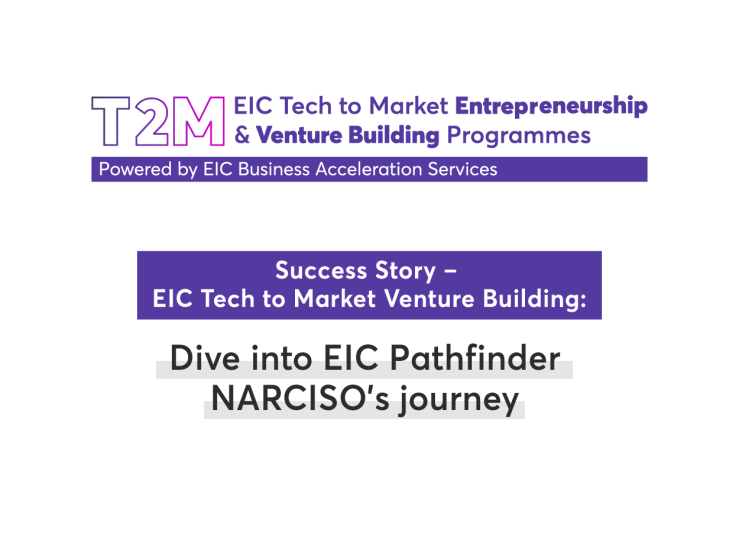Meet NARCISO, an EIC Pathfinder project that joined the EIC Tech to Market Venture Building, a programme that supports EIC Pathfinder and Transition projects reaching the market. NARCISO joined the Programme in May 2023 and is now finishing the last phase, having been part of the Tech Demo Days, Opportunities’ exploration, and Venture support services stages.
We spoke with Marco Abbarchi, Associate Professor at the Aix-Marseille University and CSO at SOLNIL, the spin-off of the NARCISO project. Abbarchi shared the goal of SOLNIL and the advantages of their solution, and how the Programme supported the team taking their innovation to the market. Keep reading to discover his experience!
Can you briefly introduce your project/start-up and its mission?
SOLNIL was created in 2020 by three co-founders: two academics (Prof. D. Grosso, CTO and Associate Prof. M. Abbarchi, CSO) and one business and industry professional (B. Kerzabi, CEO) bringing together the IP and know-how in sol-gel chemistry and nano-fabrication, photonics, business development and commercialization. Relevant activities where SOLNIL is rapidly evolving are structural colour for luxury watches, optics for high power lasers, glass texturing for displays, spectral and 3D sensing with smartphones and AR/VR.
What problem does your solution/technology address and why is it important?
Our materials are relevant to optics and photonics (they are of “optical quality”). We can improve performances while cutting costs (both CapEx and CoO) all being more sustainable with respect to conventional methods. They can be deposited on a substrate at room temperature and pressure, unlike common methods requiring high vacuum and slow deposition. The same applies to the nano-fabrication of 3D structures: we can produce them in a few fabrication steps, in ambient conditions, while avoiding toxic materials, and powerful lamps. We can cut on CO2 production, and harmful gasses for the ozone layer.
What impact do you expect your product/solution to have on your target market or industry?
In AR/VR we can deliver materials that will increase the field of view of smart-glasses and head-sets (a small field of view is one of the major limitations in these devices).
In optics for high power lasers, we can increase the maximal power that some optical elements can withstand while increasing the transparency of the optics and working angle.
More generally, in all the markets we service, we can largely reduce the costs thanks to our methods based on liquid chemistry to produce hard ceramics and our nano-imprint method to create 3D nano-structures.
What specific challenges did you face during the development of your product, and how did the Programme help you overcome them?
The EIC Tech to Market Venture Building programme was a big help by providing a study for Freedom to Operate and a deep market investigation in the AR/VR and bio-chip segments. These are important market segments for SOLNIL and it is very challenging to understand the value and supply chain, position our value proposition in the ecosystem and decide what the best go-to-market strategy is.
Can you share some concrete actions or milestones achieved during your participation in the Programme?
The most important ones are 1) the validation of our Freedom to Operate in the field of photonic metasurfaces (e.g. for AR/VR) and 2) a deep market study in the field of bio-chips for DNA sequencing and AR/VR. This latter study defined a SAM for SOLNIL that is very close to a second, independent market study from Yole Development.
How has the collaboration with the Venture Building team and mentors influenced your business strategy?
Mostly, by making SOLNL more aware of its value proposition and its realistic possibilities. While we had the ambition to build a foundry for photonic devices in EU, in the short term, a more valuable and viable approach is licensing the materials and nano-fabrication methods to third parties, such as OEM or foundries that can adopt our process.
What resources or support from the Programme were most valuable to your start-up?
The team of experts that in turn helped us in writing better pitch deck for investor, discuss about the strategy and possible issues, and above all market intelligence.
What are your future plans for the product/solution and your start-up?
The ambition is to establish SOLNIL as one stop-shop for optical and photonic devices, being capable to deliver, designs, materials and nano-fabrication processes and service large volume markets via licensing and small volume markets via in house production.
First, we will stabilize our business by licensing our materials and their deposition process to our lead customers in AR/VR (time to market ~18 months). In parallel, we will develop the nano-fabrication process to produce the 3D structures necessary for the displays used in AR/VR towards license transfer (time to market ~24 months). The same strategy will be applied to metalenses, glass texturing, and diffractive optics (e.g. for electronic displays, smartphones, imaging, auto-motive devices) (time to market ~36 months). For nice markets (<10000 wafers/year), such as high-power lasers, space, luxury, SOLNIL will start producing as soon as a customer will place a reasonably large order (>100 wafer/year) (time to market ~18 months).
If you had to summarise your experience in the EIC Tech to Market Venture Building Programme in 3 words, what would they be?
Train, sustain, and direct.
Check the summary of the interview in video, here!
About the EIC Tech to Market (T2M) Venture Building Programme
The EIC Tech to Market Venture Building Programme aims to help build start-ups to exploit promising research results through venture building services, comprising a range of activities from identification of promising business ideas to venture creation and development.
If you’re interested in knowing more about the Programme and our open calls, please visit our page in the EIC Community.
Need help?
For additional information, please refer to our helpdesk by choosing “EIC T2M Venture Building Programme” as the subject.

DISCLAIMER: This information is provided in the interest of knowledge sharing and should not be interpreted as the official view of the European Commission, or any other organisation.

